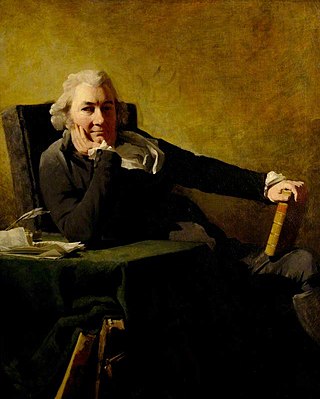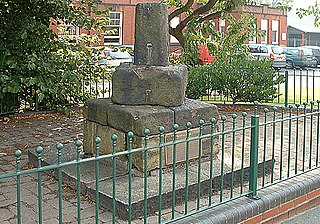Related Research Articles

Events from the year 1725 in Canada.

Events from the year 1730 in Canada.

Events from the year 1732 in Canada.

Events from the year 1734 in Canada.

Events from the year 1735 in Canada.

Events from the year 1737 in Canada.

Theophilus Cibber was an English actor, playwright, author, and son of the actor-manager Colley Cibber.

Robert Graham, who took the name Bontine in 1770 and Cunninghame Graham in 1796, was a Scottish politician and poet. He is now remembered for a poem If doughty deeds my lady please, which was later set to music by Sir Arthur Sullivan and also by his great-great-grandson, Rev. Malise Cunninghame Graham.

Events from the year 1736 in Canada.

Horsemonger Lane Gaol was a prison close to present-day Newington Causeway in Southwark, south London. Built at the end of the 18th century, it was in use until 1878.

Mab's Cross, in Wigan, Greater Manchester, England, is a stone cross probably dating from the 13th century with its first recorded mention taking place in 1277. It is one of four stone crosses originally used as waymarkers along the medieval route from Wigan to Chorley. The cross no longer stands in its original position, having been moved across the road in 1922 as part of a road widening scheme.

Hartland Abbey is a former abbey and current family home to the Stucley family. It is located in Hartland, Devon. The current owner is Sir Hugh George Copplestone Bampfylde Stucley, 6th Baronet.
Ralph Crepyn was a lawyer and the first documented Town Clerk of London in 1274. His birth was about 1245, and he was well-educated for his day. He died before 1331, but the exact date is unknown.

Chesterton Hall is a house in Chesterton, Cambridge. It lies in the city of Cambridge in the county of Cambridgeshire approximately 50 miles (80 km) north-northeast of London. Most of the grounds have long since been sold off and the house is now located on one of the major roundabouts of the city. The house dates from the early 17th century.

Philip Darnall, was an English barrister. His son Henry Darnall, (1645–1711), emigrated to North America, where he became the Proprietary Agent of George Calvert, the first Lord Baltimore, (1579–1632), and George Calvert's son, Cecilius Calvert, second Lord Baltimore, (1605–1675) and the founder of Maryland.

Sir Richard Thomas Gilpin, 1st Baronet was an English Conservative politician who sat in the House of Commons from 1851 to 1880.
Colonel William Digges was a prominent planter, soldier and politician in the Colony of Virginia and Province of Maryland. The eldest son of Edward Digges (1620-1674/5), who sat on the Virginia Governor's Council for two decades but died shortly before Bacon's Rebellion, Digges fled to Maryland where he married Lord Calvert's stepdaughter and served on the Maryland Proprietary Council until losing his office in 1689 during the Protestant Revolution, when a Puritan revolt upset the Calvert Proprietorship. His eldest son Edward sold his primary Virginia plantation to his uncle Dudley Digges. It is now within Naval Station Yorktown. His former Maryland estate, Warburton Manor, is now within Fort Washington Park. Two additional related men with the same name served in the Virginia General Assembly, both descended from this man's uncle and his grandson Cole Digges (burgess): William Digges (burgess) and his nephew and son-in-law William Digges Jr. both represented now-defunct Warwick County, Virginia.

Events from the year 1727 in Canada.
William Bladen (1672–1718) was an English-born Attorney-General in Maryland, in what is now the United States, and briefly Secretary of that Province. He was the father of Thomas Bladen, Governor of Maryland and was the brother of Colonel Martin Bladen, Commissioner of the Board of Trade and Plantations. His nephew was Admiral Edward Hawke, 1st Baron Hawke.
Colonel Martin Bladen (1680–1746) was a British politician who sat in the Irish House of Commons from 1713 to 1727 and in the British House of Commons from 1715 to 1746. He was a Commissioner of the Board of Trade and Plantations, a Privy Councillor in Ireland and Comptroller of the Mint.
References
- ↑ Conlin, D.(2009)Pirates of the Atlantic: Robbery, Murder and Mayhem off the Canadian East Coast. Halifax: Formac Publishing Company Ltd.
- ↑ Letter from L. Armstrong to the Council of Trade and Plantations, 23 November 1736. Retrieved from http://www.british-history.ac.uk/report.aspx?compid=72856
- ↑ Letter from L. Armstrong to The Council of Trade and Plantations, 19 June 1736. Retrieved from http://www.british-history.ac.uk/report.aspx?compid=72846
- ↑ Marine Heritage Database: Baltimore 1735. Retrieved from https://novascotia.ca/museum/wrecks/wrecks/shipwrecks.asp?ID=541
- Conlin, D.(2009)Pirates of the Atlantic: Robbery, Murder and Mayhem off the Canadian East Coast. Halifax: Formac Publishing Company Ltd.